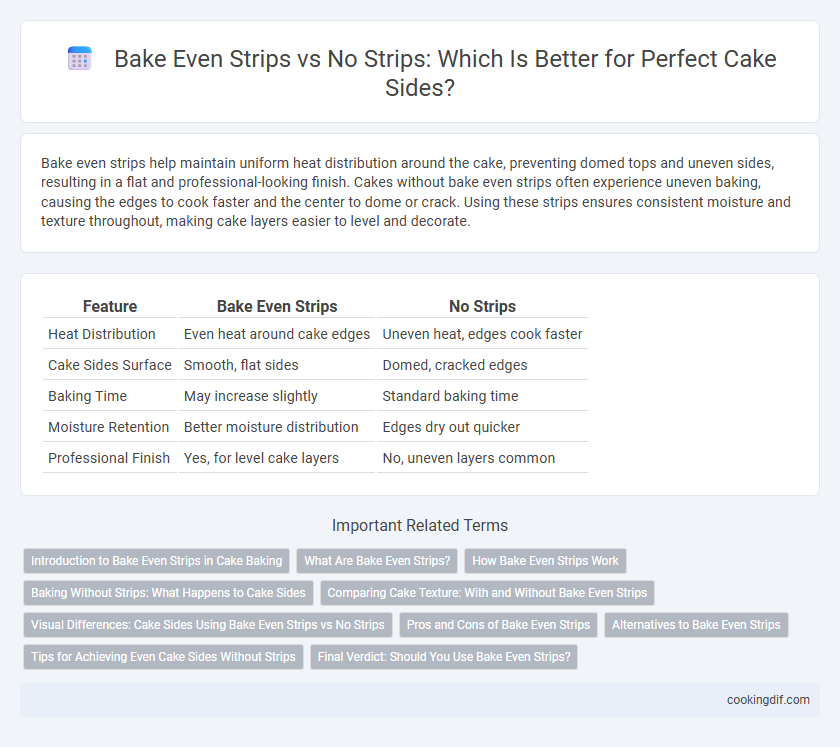Bake even strips help maintain uniform heat distribution around the cake, preventing domed tops and uneven sides, resulting in a flat and professional-looking finish. Cakes without bake even strips often experience uneven baking, causing the edges to cook faster and the center to dome or crack. Using these strips ensures consistent moisture and texture throughout, making cake layers easier to level and decorate.
Table of Comparison
| Feature | Bake Even Strips | No Strips |
|---|---|---|
| Heat Distribution | Even heat around cake edges | Uneven heat, edges cook faster |
| Cake Sides Surface | Smooth, flat sides | Domed, cracked edges |
| Baking Time | May increase slightly | Standard baking time |
| Moisture Retention | Better moisture distribution | Edges dry out quicker |
| Professional Finish | Yes, for level cake layers | No, uneven layers common |
Introduction to Bake Even Strips in Cake Baking
Bake even strips are moisture-retaining fabric bands wrapped around cake pans to prevent the edges from baking faster than the center, ensuring uniform cake layers. These strips stabilize temperature distribution, reducing doming and cracking during baking, which results in a more level cake ideal for decorating. Without bake even strips, cakes often develop uneven sides and may require additional leveling, impacting the final presentation and texture.
What Are Bake Even Strips?
Bake Even Strips are fabric strips soaked in water and wrapped around cake pans to insulate the sides, ensuring the cake bakes evenly by preventing the edges from cooking faster than the center. These strips help maintain a consistent temperature throughout the batter, reducing domed tops and cracks for a flat, professional-looking cake layer. Using Bake Even Strips can improve baking results, especially with dense or large cakes prone to uneven rising.
How Bake Even Strips Work
Bake Even Strips work by insulating the cake pan, promoting slower and more even heat distribution around the sides of the cake. This prevents the outer edges from baking faster than the center, reducing doming and creating a flat, uniform cake surface. Without these strips, cakes often develop rounded edges and uneven textures due to uneven heat exposure.
Baking Without Strips: What Happens to Cake Sides
Baking cake without even strips often results in domed or cracked tops and uneven sides due to temperature fluctuations during baking, causing the edges to cook faster than the center. The lack of insulation allows the cake sides to bake and set prematurely, leading to a pronounced dome and potential overcooked edges. This uneven baking can affect cake aesthetics and texture, making it challenging to achieve flat layers for stacking or decorating.
Comparing Cake Texture: With and Without Bake Even Strips
Bake even strips help regulate heat distribution around the cake, resulting in more even baking and a uniform texture throughout the cake layers. Without bake even strips, the cake sides tend to rise faster than the center, causing domed or uneven textures that may affect crumb consistency. Using these strips can produce a moist, tender crumb by preventing overcooked edges and undercooked centers, enhancing the overall cake quality.
Visual Differences: Cake Sides Using Bake Even Strips vs No Strips
Bake Even Strips create uniformly flat and smooth cake sides by insulating the edges, which prevents doming and uneven baking. Cakes without strips often develop rounded or cracked sides due to uneven heat distribution, resulting in a less polished appearance. Using Bake Even Strips enhances the visual appeal by ensuring clean, straight edges ideal for professional decorating.
Pros and Cons of Bake Even Strips
Bake Even Strips help maintain consistent cake layers by preventing domed tops, ensuring even baking and a smooth, flat surface for stacking and decorating. They improve heat distribution and reduce the need for leveling, saving time and effort. However, they require soaking before use and proper fitting around pans, which may add preparation time and potential mess.
Alternatives to Bake Even Strips
Silicone bake even strips provide a reusable alternative to traditional fabric strips, offering consistent insulation for cake edges to prevent doming and over-browning. Using dampened towels wrapped around cake pans or layering cake pans in a water bath also helps distribute heat evenly, reducing the need for commercial bake even strips. Aluminum foil insulation combined with homemade cotton strips soaked in water can mimic the heat-retaining properties, ensuring a level bake without specialized tools.
Tips for Achieving Even Cake Sides Without Strips
Using a ruler to measure cake batter levels before baking ensures even layers and smooth sides. Chilling the cake layers in the refrigerator after baking tightens crumbs, making icing application easier and neater. Applying a thin crumb coat before the final frosting layer creates a smoother cake surface, eliminating imperfections without using bake even strips.
Final Verdict: Should You Use Bake Even Strips?
Bake even strips effectively prevent dome-shaped cakes by evenly distributing heat around the pan, resulting in flat, uniform cake sides ideal for stacking and decorating. Without these strips, cakes tend to rise unevenly, creating rounded or cracked tops that require trimming and compromise final presentation. For bakers seeking professional, consistent results, using bake even strips is a recommended practice for achieving smooth, level cake layers.
Bake Even Strips vs No Strips for cake sides Infographic

 cookingdif.com
cookingdif.com